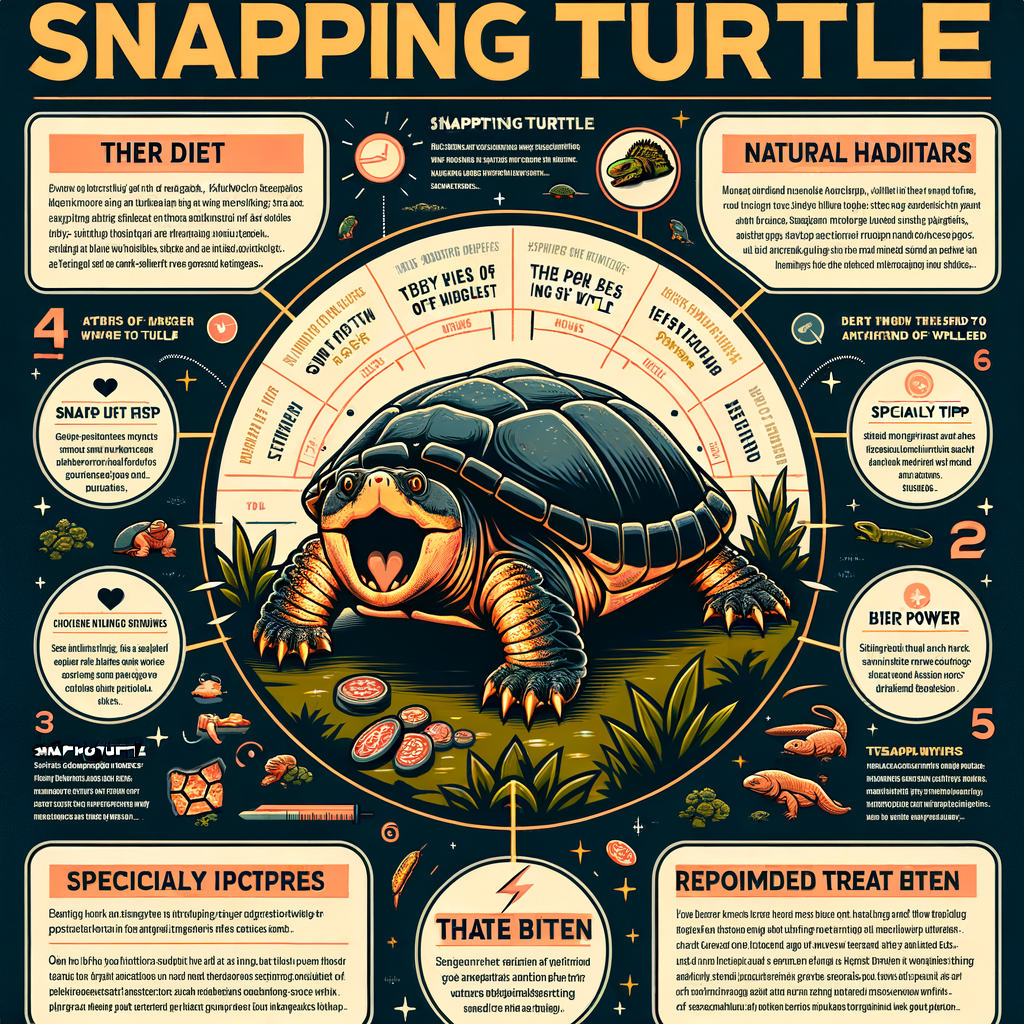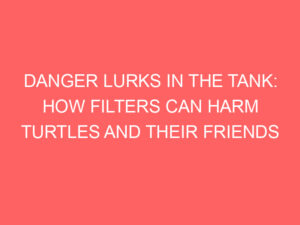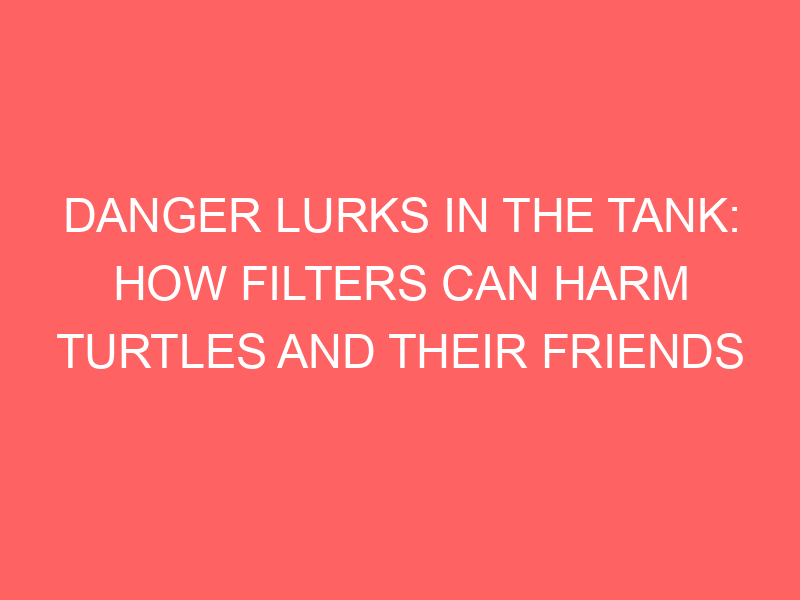
Introduction to Snapping Turtles
Welcome to the fascinating world of snapping turtles! These creatures are known for their powerful jaws and long, flexible necks. But there’s so much more to learn about them. Let’s dive in and explore!
- Overview of Snapping Turtles
- Snapping Turtle Facts
- Snapping turtles are one of the oldest living reptiles, with fossils dating back 15 million years.
- They can live up to 100 years in the wild.
- Snapping turtles have a very strong bite, which they use for catching prey and defending themselves.
- Despite their fearsome reputation, snapping turtles are generally not aggressive unless threatened.
- Their diet includes a wide range of food, from plants to small animals.
Snapping turtles are large, freshwater turtles that are native to North America. They are easily recognized by their big, heavy shells, and their strong, beak-like jaws. Snapping turtles live in a variety of water bodies, including ponds, streams, and lakes. They are most active at night and spend most of their day resting at the bottom of the water.
Here are some interesting facts about snapping turtles:
In the following sections, we will delve deeper into the life of snapping turtles, their diet, their powerful bite, and how to care for them if you ever come across one. Stay tuned!
Understanding Snapping Turtles
Snapping turtles are fascinating creatures with unique behaviors and defense mechanisms. Let’s delve into understanding these aspects better.
Snapping Turtle Behavior
Snapping turtles exhibit a range of behaviors that are intriguing and sometimes surprising. We will explore two main aspects: their typical behavior patterns and their aggression and defense mechanisms.
- Typical Behavior Patterns
- Aggression and Defense Mechanisms
Snapping turtles are primarily aquatic and spend most of their time in water. They are known to be solitary creatures, preferring to be alone rather than in groups. They are also nocturnal, meaning they are most active during the night. During the day, they often hide under mud or vegetation in the water. They are excellent swimmers and can stay submerged for up to three hours without coming up for air!
Snapping turtles have a reputation for being aggressive, but this is mostly a defense mechanism. When they feel threatened, they can snap their jaws as a warning to potential predators. Their powerful jaws are their primary form of defense. However, it’s important to note that they usually only display this behavior when they are out of water and feel vulnerable. In water, they prefer to swim away from threats rather than confront them.
In conclusion, snapping turtles are solitary, nocturnal, and prefer to avoid conflict when possible. Their aggressive behavior is mainly a defense mechanism used when they feel threatened. Understanding these behaviors can help us appreciate these unique creatures and their important role in the ecosystem.
Snapping Turtle Habitat
Snapping turtles are fascinating creatures with unique living conditions. They can be found in a variety of natural habitats and have an incredible ability to adapt to different environments. Let’s explore these aspects in more detail.
- Natural Habitats
- Adaptation to Different Environments
Snapping turtles are primarily freshwater animals. They are native to North America and are commonly found in ponds, lakes, and slow-moving rivers. These turtles prefer water bodies with muddy bottoms where they can easily hide and hunt. They also enjoy areas with plenty of vegetation, which provides them with food and cover from predators.
Snapping turtles can also be found in brackish waters – a mix of fresh and saltwater. This shows their ability to survive in diverse conditions. However, they are not typically found in fast-flowing waters or deep, open areas. They prefer shallow, quiet waters where they can easily reach the surface to breathe.
Snapping turtles are incredibly adaptable creatures. They can tolerate a wide range of temperatures and can survive in both warm and cold climates. In fact, they are one of the few turtle species that remain active in cold water during the winter months. This is possible because they can breathe through their skin, allowing them to stay underwater for extended periods, even when the surface is frozen.
Snapping turtles also have a unique ability to survive in polluted waters. They have been found in urban and suburban areas, living in man-made ponds and drainage ditches. This adaptability has helped them survive in areas where other turtle species have declined.
In conclusion, the snapping turtle’s ability to adapt to different environments and tolerate a wide range of conditions has contributed to its survival and success as a species. This adaptability, combined with their unique natural habitats, makes them a fascinating subject of study.
Snapping Turtle Diet
Understanding the diet of snapping turtles is crucial for their survival, both in the wild and in captivity. Let’s explore what these fascinating creatures eat.
- Common Foods in the Wild
Snapping turtles are omnivores, which means they eat both plants and other animals. In the wild, their diet is diverse and depends on what’s available in their environment.
| Food Type | Examples |
|---|---|
| Plants | Algae, aquatic plants, and fallen fruits |
| Animals | Fish, frogs, snakes, small birds, and even small mammals |
Snapping turtles are not picky eaters. They are known to eat almost anything they can catch and fit into their mouths. This wide-ranging diet helps them to survive in various habitats.
- Dietary Needs in Captivity
When kept as pets, snapping turtles require a balanced diet to stay healthy. It’s important to replicate their natural diet as closely as possible, with a mix of both plant and animal matter.
| Food Type | Examples |
|---|---|
| Plants | Leafy greens, carrots, and sweet potatoes |
| Animals | Small fish, earthworms, and mealworms |
Feeding your pet snapping turtle a varied diet will ensure they receive all the necessary nutrients. Remember, overfeeding or feeding them inappropriate food can lead to health problems. Always consult with a vet or a turtle expert to ensure your pet’s diet is balanced and appropriate.
The Power of Snapping Turtle Bite
Snapping turtles are known for their powerful bites. But how strong is a snapping turtle’s bite exactly? Let’s dive into the details.
Snapping Turtle Bite Force
The bite force of a snapping turtle is something to be reckoned with. These creatures can exert a significant amount of pressure when they bite, making them one of the most powerful biters in the animal kingdom.
- Comparison with Other Animals
- Factors Influencing Bite Force
Compared to other animals, the snapping turtle’s bite force is quite impressive. For instance, a human has a bite force of around 162 pounds per square inch (PSI), while a snapping turtle can exert a force of up to 1,000 PSI. That’s over six times stronger than a human’s bite!
Several factors can influence the bite force of a snapping turtle. These include the turtle’s size, age, and health. Larger, older turtles tend to have a stronger bite force. Additionally, a healthy turtle with a well-balanced diet will likely have a stronger bite than a malnourished one.
Understanding the power of a snapping turtle’s bite is essential, especially for those who handle these creatures. It’s always important to handle them with care and respect their strength.
Snapping Turtle Bite Effects
When a snapping turtle bites, it can cause two main types of effects. These include physical damage and potential health risks. Let’s delve deeper into these effects:
- Physical Damage
- Potential Health Risks
Snapping turtles have a powerful jaw that can cause significant physical damage. Their bites can lead to deep cuts, bruises, and in severe cases, even broken bones. For instance, a study conducted by the University of Florida found that a large snapping turtle could exert a bite force of up to 1000 Newtons. This is strong enough to break a human finger!
Also, due to the sharpness of their beak-like jaws, a snapping turtle bite can tear through skin and muscle tissue easily. This can result in painful wounds that take a long time to heal. It’s important to remember that the severity of the physical damage depends on the size and strength of the turtle, as well as the location of the bite.
Aside from the physical damage, a snapping turtle bite can also pose potential health risks. One of the main concerns is the risk of infection. Snapping turtles often live in environments that may be contaminated with bacteria, viruses, or parasites. When they bite, these microorganisms can be transferred into the wound, leading to infections.
Some of the common symptoms of an infection include redness, swelling, and pus formation around the bite area. In some cases, the infection can spread to other parts of the body, causing fever, chills, and other severe health problems. Therefore, it’s crucial to clean and disinfect a snapping turtle bite as soon as possible to reduce the risk of infection.
In conclusion, a snapping turtle bite can cause both physical damage and potential health risks. Therefore, it’s important to handle these creatures with care and respect. If you or someone else is bitten by a snapping turtle, seek medical attention immediately to ensure proper treatment and avoid complications.
Snapping Turtle Bite Treatment
When it comes to snapping turtle bites, it’s important to know how to respond. Here are some key steps to take if you or someone else is bitten by a snapping turtle.
- First Aid Measures
- When to Seek Medical Attention
Firstly, don’t panic. It’s crucial to stay calm so you can think clearly and act quickly. Rinse the wound with warm water to clean it. Then, apply an antiseptic to prevent infection. If the bite is bleeding, apply pressure with a clean cloth to stop the blood flow. It’s also a good idea to elevate the wound above the heart if possible. This can help reduce swelling and pain.
While some snapping turtle bites can be treated at home, others require medical attention. If the bite is deep, if it’s on the face or neck, or if it doesn’t stop bleeding after 15 minutes of pressure, it’s time to seek medical help. Also, if the person who was bitten starts to feel sick, has a fever, or notices red streaks spreading out from the wound, these are signs of a possible infection and they should see a doctor immediately.
Remember, the best way to avoid a snapping turtle bite is to respect these creatures from a safe distance. However, if a bite does occur, knowing how to react can make a big difference in the outcome.
Snapping Turtle Care
When it comes to caring for snapping turtles, there’s a lot to consider. These unique creatures require a specific environment and diet to thrive. Let’s delve into the details of keeping snapping turtles as pets.
Keeping Snapping Turtles as Pets
Snapping turtles can make interesting pets for those who are prepared to meet their unique needs. However, they are not suitable for everyone. Here are some pros and cons, as well as essential care tips for keeping snapping turtles as pets.
- Pros and Cons
Snapping turtles are fascinating creatures with unique behaviors, which can be rewarding to observe. They are also long-lived, meaning you can enjoy their company for many years. However, they require a large, well-maintained habitat and a specific diet, which can be time-consuming and costly. Additionally, snapping turtles can be aggressive and are not suitable for handling, making them less ideal for families with young children.
- Essential Care Tips
Snapping turtles require a large aquatic habitat with plenty of room to swim and a dry area to bask. The water should be kept clean and at an appropriate temperature. They eat a varied diet of fish, meat, and some fruits and vegetables. It’s also important to provide them with a UVB light for basking. Regular vet check-ups are essential to monitor their health.
In conclusion, snapping turtles can make rewarding pets for the right person. However, they require a significant commitment in terms of time, resources, and understanding of their unique needs. If you’re considering getting a snapping turtle as a pet, make sure you’re fully prepared to provide the care they need.
Conservation Efforts for Snapping Turtles
Snapping turtles are a vital part of our ecosystem, but they face several threats that are causing their numbers to dwindle. Let’s explore these threats and the current measures being taken to protect these fascinating creatures.
- Threats to Snapping Turtles
- Habitat Loss: As humans continue to expand their cities and towns, the natural habitats of snapping turtles are being destroyed. This makes it harder for them to find food and safe places to lay their eggs.
- Pollution: Chemicals and waste from human activities are polluting the waters where snapping turtles live. This can make them sick and even lead to death.
- Climate Change: Changes in temperature and weather patterns can disrupt the normal life cycle of snapping turtles. For example, warmer temperatures can cause more eggs to hatch as females, leading to an imbalance in the population.
- Current Conservation Measures
- Protected Areas: Establishing protected areas where snapping turtles can live without the threat of habitat destruction is one of the most effective conservation strategies.
- Legislation: Laws have been passed in many places to protect snapping turtles from being hunted or captured. This helps to ensure that their population can recover.
- Education: Teaching people about the importance of snapping turtles and how to protect them is another crucial part of conservation efforts. When people understand why these creatures are important, they are more likely to take steps to protect them.
Snapping turtles are facing a number of challenges that are threatening their survival. These include:
Despite these challenges, there are several measures being taken to protect snapping turtles. These include:
In conclusion, while snapping turtles face many threats, there are also many efforts being made to protect them. By understanding these threats and conservation measures, we can all play a part in ensuring the survival of these fascinating creatures.
Conclusion
-
Recap of Key Points
Let’s revisit what we’ve learned about snapping turtles. Firstly, we discovered that snapping turtles are fascinating creatures with unique characteristics. They are one of the oldest and most resilient species on earth, having been around for millions of years.
Secondly, we delved into their diet, which primarily consists of fish, insects, and even small mammals. Their powerful bite is a key survival tool, allowing them to capture and consume their prey efficiently.
Lastly, we discussed how to care for a snapping turtle. They require a specific habitat, a balanced diet, and regular check-ups to ensure they remain healthy and happy.
-
Final Thoughts on Snapping Turtles
Snapping turtles are truly remarkable creatures. Their resilience, power, and unique dietary habits make them a fascinating subject of study. However, they are not pets for everyone. Their care requires a significant commitment and understanding of their needs.
Remember, these turtles play a crucial role in our ecosystem, and it’s our responsibility to respect and protect them. As we continue to learn more about these amazing creatures, we can better appreciate their role in nature and our world.














